
Andy Lloyd's Dark Star Blog

Blog 63 (June 2018)
Space Grease and Interstellar Objects
My yelp of delight upon hearing about this on the radio this morning was joyous. Mrs DarkStar commented that few homes in the land would have met such a story in this way. True, but few householders have written 98% of a book about missing planets and novel forms of planetary formation, and just need one more jigsaw piece to finish it. And here it is: Space grease! Admittedly, this does not sound too exciting. But I have faced a problem figuring out just what can stick interstellar protoplanets together, given a lack of gas pressure in interstellar space (this gas pressure, apparent in the early solar system's pre-solar nebula and subsequent protoplanetary disk, likely plays a part in granular accretion).
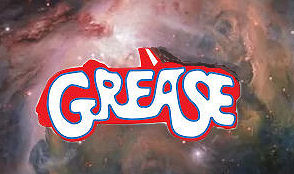
Space Grease accumulates on the windshield of interstellar travellers
What better way to accrete than space grease? There's masses of it out there (10 billion trillion trillion tonnes in the Milky Way), created in stars, and distributed across space:
"Prof Tim Schmidt, a chemist at the University of New South Wales, Sydney and co-author of the study, said that the windscreen of a future spaceship travelling through interstellar space might be expected to get a sticky coating. “Amongst other stuff it’ll run into is interstellar dust, which is partly grease, partly soot and partly silicates like sand,” he said, adding that the grease is swept away within our own solar system by the solar wind." (1)
Material moving through interstellar space encounters this grease routinely, then. It will stick to surfaces. Over billions of years of such interactions, major accumulations of this type of gloop will build up on objects, like interstellar comets, and free-floating asteroids and planets. The first interstellar object to be directly observed moving through our solar system was 1I/'Oumuamua, a tumbling, shard-shaped object which was detected last autumn (2,3).
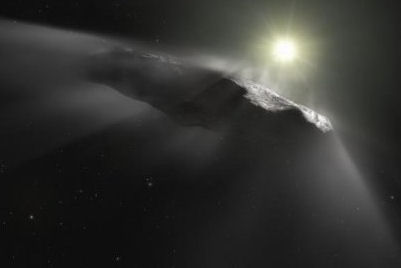
An artistic depiction of the interstellar asteroid/comet 1I/'Oumuamua.
Image Credit: ESA/Hubble/M. Kornmesser
Such objects were expected to behave like comets, and outgas as they approach the Sun. However, this object did not spray the solar system with its internal gases, leading astronomers to conclude that this object had originally been an asteroid which had been ejected from another star system. However, recent observations and work on 1I/'Oumuamua's trajectory indicate that its motion is being affected by another factor beyond gravitational interactions - it is moving faster than it should (4). This is thought to be due to outgassing after all, leading to the conclusion that this object is an interstellar comet (5).
"Such outgassing is a behaviour typical for comets and contradicts the previous classification of `Oumuamua as an interstellar asteroid. “We think this is a tiny, weird comet,” commented Marco Micheli. “We can see in the data that its boost is getting smaller the farther away it travels from the Sun, which is typical for comets.”
"“We did not see any dust, coma, or tail, which is unusual,” explained co-author Karen Meech of the University of Hawaii, USA. Meech led the discovery team’s characterisation of `Oumuamua in 2017. “We think that ‘Oumuamua may vent unusually large, coarse dust grains.”" (5)
This idea rests upon the erosion of the comet through interstellar space - the exact opposite of what I'm advocating. From our local perspective, interstellar space begins beyond the heliopause, which means that all solar system objects lying outside the Sun's heliosphere are in interstellar space, including any potential Planet X body. A heavy coating of space gloop on 1I/'Oumuamua would readily explain the lack of cometary tail: The main body of the body is so covered by a thick coating of grease, which would have toasted nicely during perihelion, that the volatiles were locked in. The dark red surface of 1I/'Oumuamua shows variation in tone and colour (6), which is probably attributable to thick coverings of organic materials irradiated in interstellar space. Such a covering could seal in the comet's volatiles, largely preventing the expected spectacular comet display at perihelion. Rather like tarring a wooden boat to keep it watertight.
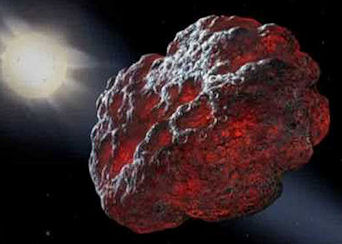
This comet/asteroid has been colliding with 'space grease' and other materials for as long as it has been tumbling through interstellar space, the amount of which seem significantly higher than previously thought:
"Until now there has been uncertainty over how much carbon is drifting between the stars. About half is expected to be found in its pure form. The rest is chemically bound with hydrogen in either a grease-like form, known as aliphatic carbon, or as a gaseous version of naphthalene, the main chemical component of mothballs.
"Helen Fraser, a senior lecturer in astronomy at the Open University, said: “It remains a major question in astronomy how dust forms, evolves and is destroyed.” Fraser said the work suggests that are many more “grease-like” molecules in space than previously thought. “The consequence could be important in how such dust grains stick and form planets, or even ‘seed’ planetary surfaces with the ingredients for the origins of life,” she added." (1)
This raises the prospect of continuous accumulation of materials in interstellar space, as I have been arguing for a while (7). Protoplanets ejected from young, chaotic planetary systems can continue to accumulate mass while floating freely in interstellar space, I argue. This mops up interstellar materials, condensing their distribution into a more granular, i.e. dark planets. We can't see them, because they are not illuminated by local stars. I argue that such objects are more pervasive through the galaxy than previously though, adding to it overall mass. This explains where all this space grease is, which remains a mystery in terms of direct observation:
"The resultant aliphatic carbon [a hydrocarbon with no aromatic ring] column densities are least five times higher than some values reported previously. Using the two ISDA [interstellar dust analogues] integrated absorption coefficients, we obtained an abundance range between ~ 54−135 ppm for aliphatic carbon in the ISM [Interstellar Medium]. This leaves a substantial proportion of the dust-bound carbon to be found in aromatic or olefinic structures." (8)
This space grease is surely an incredibly important component in planet-building, helping to explain why colliding materials don't simply blast away from each other at the kinds of speeds they are travelling relative to one another. Instead, they stick together.
Written by Andy Lloyd,
30th June 2018
References:
1)
Hannah Devlin "Space is full of dirty, toxic grease, scientists reveal" 27 June 20182) Andy Lloyd "'Oumuamua's Many Cousins" 21 January 2018,
andylloyd.org/darkstarblog58.htm
3) Elizabeth Landau "Chasing 'Oumuamua" 27 June 2018
4) ESO Pres release 1820 "ESO’s VLT Sees `Oumuamua Getting a Boost: New results indicate interstellar nomad `Oumuamua is a comet", 27 June 2018,
5) Marco Micheli et al. "Non-gravitational acceleration in the trajectory of 1I/2017 U1 (‘Oumuamua)", Nature, 27 June 2018;
6) Meech, K. J. et al. "A brief visit from a red and extremely elongated interstellar asteroid", Nature 2017, 552: pp 378–381
7) Andy Lloyd "The Cumulative Effect of Intermittent Interstellar Medium Inundation Upon Objects In The Outer Solar System" 02/2016, DOI: 10.13140/RG.2.1.5112.5526 - an updated version (22/2/16) is available here:
8) B. Günay et al. "Aliphatic Hydrocarbon Content of Interstellar Dust" Monthly Notices of the Royal Astronomical Society, 13 June 2018,
Planet Nine and the Kuiper belt
In conjunction with a scientist from the University of Michigan, the Caltech team who originally coined the term Planet Nine in 2016 have written a new paper about its formation, and the subsequent layout of the outer solar system.
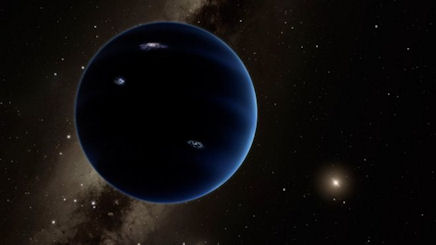
Planet Nine. Image credit: Caltech, 2016
Having set out the evidence for this proposed object in the paper (1), they note three possible scenarios for its formation:
1) The planet's capture from the retinue of a passing star; or, alternatively, the capture of a free-floating interstellar planet
2) The planet's semi-ejection from the inner solar system and subsequent gradual drift outwards
3) The planet's formation in situ.
All three of these scenarios require certain conditions for them to work, which means that no single formation theory stands out as particularly probable. The capture and scattering models depend upon the interjection of outside bodies (passing stars or brown dwarfs, or objects in the Sun's birth cluster). The in situ formation of a planet so far from the Sun implies that the Sun's protoplanetary disk was significantly larger than generally accepted. The formation of Planet Nine in its calculated position thus remains problematic, based upon standard models of planetary and solar system formation (e.g. the Nice model). Further, whatever processes which placed it in its proposed current position would have significantly affected the layout of the Kuiper belt within its overarching orbit. This factor is what the current investigation described by this paper aims to solve.
This paper then describes computer simulations of the early Kuiper belt, and how the shape and extent of the fledgling belt may have affected the complex interplay between it, Planet Nine, and the objects in the extended scattered disk (1). The research team modelled two distinct scenarios for the early Kuiper belt, each of which matches one or more formation scenarios for Planet Nine. The first is a 'narrow' disk, similar to that observed: The Kuiper disk appears to be truncated around 50AU, with objects found beyond this zone likely having been scattered outwards by processes which remain contentious. The second scenario is a 'broad' disk, where objects in the Kuiper belt would have routinely populated the space between Neptune and the proposed orbit of Planet Nine, hundreds of astronomical units out. This would match a formation scenario involving an extensive protoplanetary disk.
Two scenarios for the early Kuiper belt's distribution.
Image credit: Khain, Batygin & Brown, 2018
Once the theoretical Planet X object is in place, the computer
simulations seek to discover whether the scattered outer solar system
objects in its domain can stabilise in its presence. many of these
objects are adversely affected by the presence of Planet Nine over time:
their orbits 'librate' through numerous interactions. In the
accompanying blog article to explain their paper, Khain provides helpful
animations to explain these oscillating orbital behaviours, drawing an
analogy with the wagging tail of a dog (2). Sometimes, the
librations are quiet, natural fluctuations in the orbits. At other
times, the librations destabilise and the oscillating object kicks off.
The calculations showed that the broad early Kuiper belt generated a
bimodal structure of scattered objects associated with Planet Nine -
some aligned, some anti-aligned with its position in space (1).
The average distances from the Sun for these scattered objects is
considerably greater than normal KBOs - making it difficult to find them
using current observational technologies.
"We compute that the median final perihelion
distance of the detectable objects in the narrow distribution is 38.13
AU for the anti-aligned KBOs and 33.07 AU for the aligned KBOs, and in
the broad distribution, 44.16 AU for the anti-aligned KBOs, and 100.29
AU for the aligned KBOs." (1)
The researchers note that the averaged distances for the anti-aligned
objects is similar in both Kuiper belt scenarios (the broader
anti-aligned objects seem to be perturbed back down into the solar
system, becoming centaurs). The real difference is seen in the
aligned objects, whose distributions vary greatly with initial Kuiper
belt conditions.
"So, what’s the bottom line? Not all
anti-aligned objects are stable! And not all aligned objects are stable.
And it all depends on their perihelion distance, which is closely tied
with their librations in longitude of perihelion. Moreover, it turns
out that what kind of objects we find surviving through the end of our
simulations depends on the initial conditions we put in. What do I mean
by initial conditions? Well, for example, we expect that different
scenarios of Planet Nine’s formation would have affected the initial
configuration of the Kuiper belt in different ways." (2)
The team also ran simulations with Planet Nine in the plane of the
planets, and inclined to the ecliptic, finding little difference in
their results. This is important because Planet Nine is thought to
be highly inclined to the ecliptic.
Aligned and anti-aligned scattered objects with respect to Planet Nine.
Image credit: Khain, Batygin & Brown, 2018
The shape and configuration of the Kuiper belt depends upon which of the above formation scenarios is correct for Planet Nine. Certain configurations appear to shape the cluster in different ways, allowing astronomers to potentially work backwards from future discoveries to determine how Planet Nine came to be. The team draw this conclusion:
"Thus, the presence of high-q [large semi-major axis] aligned objects in our solar system would not only lend support for the existence of Planet Nine but would indicate that our current Kuiper Belt stems from an initially wide q-distribution. This, in turn, would signal that Planet Nine’s formation likely involved stellar encounters, as this is the most likely mechanism that would create such a spread out Kuiper Belt." (1)
What I'm taking from this is that the aligned objects are no longer considered to be in an unstable situation. Potentially, then, Planet Nine could be oriented with this cluster in physical space. If so, then Planet Nine could be in the opposite side of the sky to that indicated by the Caltech team in 2016.
In reviewing the clustering effects of the extended trans-Neptunian objects (ETNOs), there appears to be a shift in emphasis on whether the objects which are aligned or anti-aligned to Planet Nine are stable. I detect movement on this issue, which may have a significant impact upon the projected location of the planet itself. Regrettably, my questions to Mike Brown on this issue have gone unanswered. Ever since the first paper about Planet Nine was published, I have argued that their analysis about the planet's position is diametrically opposite to a previous body of evidence about the location of Planet X (3). I suggest that the aligned/anti-aligned bodies in the initial Planet Nine cluster are the wrong way around, and that this will become increasingly apparent as more of these scattered objects are discovered.
If the broad early Kuiper belt scenario is correct, then there may be a substantial population of scattered objects awaiting discovery, whose average distances spread out significantly. The current cluster of ETNOs could be the tip of the proverbial iceberg. If this potential population is discovered as the ability to detect such distant objects improves, then it could have repercussions on our understanding of the Sun's birth environment within an early stellar cluster. This paper provides such a theoretical model, assuming, of course, the presence of Planet Nine.
Written by Andy Lloyd,
26th June 2018
References:
1)
Tali Khain, Konstantin Batygin & Michael E. Brown “The Generation Of The Distant Kuiper Belt By Planet Nine From An Initially Broad Perihelion Distribution” 1 May 2018,2) Tali Khain “Planet Nine makes some KBOs go wild” 7th May 2018
3) Andy Lloyd "Planet Nine Constellations Predicted by Sitchin, and IRAS" 26th January 2016,
andylloyd.org/darkstarblog34.htm
An Alternative Explanation for the ETNOs?
There are a growing number of objects in the outer solar system which defy explanation. These objects are located further out than the objects in the Kuiper Belt and, unlike these inner cousins, they are not 'shepherded' by the planet Neptune. This semi-detached set of objects forms the extended scattered disk. Sedna is an example, whose far flung orbit was discovered back in 2002. In recent times, patterns have emerged among some of these objects which suggests an explanation for this eccentric behaviour: They appear to have been perturbed into these weird orbits by the action of a missing planet located same way beyond them. They provide evidence, many astronomers suggest, for the existence of Planet X, or, as it is now referred to in academic circles, Planet Nine.
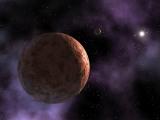
But not everyone agrees, and other explanations have been offered to explain this strange orbits. High on the list are the action of passing stars during the lifetime of the solar system. Again, such an explanation relies upon the temporary incursion of a massive objects, which draws out some of the Kuiper Belt objects. Another possibility is that the objects in the extended scattered disk (ETNOs) originated within the comet clouds - more specifically, the inner Oort cloud, of Hills cloud. They may be transitioning comets which will eventually become Halley-like comets closer in to the Sun.
A new explanation, offered by scientists working at Boulder, Colorado is that these objects aren't really so weird after all. They have set up some computer simulations which suggest that they orbital paths may become more eccentric and extended simply as a result of gravitational interactions from within the Kuiper Belt itself (1). If true, then there is no need to seek out Planet Nine (which is proving evasive, despite the near certainty with which it is being claimed). Although a series of small-scale perturbations may provide a model to explain anomalies, such an explanation does not seem to offer an explanation for the patterning of the ETNOs, however. One would expect such a series of small-scale events to randomise the effect. It may also not explain the highly inclined nature of some of these objects (2).
I suspect Mike Brown et al. will shortly respond and point out their analysis of the common 'argument of perihelion' of these objects. This is a technical issue, but an important one. A series of small-scale adjustments over time would randomise the effect, and not create such a definitive clustering.
Written by Andy Lloyd,
19th May 2018
References:
1)
Deborah Byrd "No Planet Nine? Collective gravity might explain weird orbits at solar system’s edge" 10 June 2018,with thanks to Al2) Andy Lloyd "New Object Adds Grist to the Planet Nine Mill" 22 May 2018,
andylloyd.org/darkstarblog62.htm
Return of Sumerian Religion
The ancient religious beliefs of the Sumerians are making a comeback - in Iceland. Zuism, defined as Sumerian-Mesopotamian Neo-paganism, draws upon the world's oldest myths and pantheon of gods - the epic tales of Anu, Enlil and Enki (1). It became registered as a religion in Iceland in 2013. Much of the drive to promote this quietly resurgent religion appears to derive from tax laws in Iceland: The numbers being crunched on Zuist accountants' clay tablets seem to offer a loop-hole for devotees wishing to sidestep parish fees (2). As the objectives set out by the organisation seemed to be political, rather than spiritual, Icelandic Zuists have begun to put some flash on the old Mesopotamian bones, to avoid charges that Zuism isn't really a religion at all.

Image credit: Zuist Society
Now, Iceland's neo-pagan movement hopes to build a ziggurat-inspired temple, and have sought planning permission
from Reykjavik City Council. Simply called 'The Ziggurat', it will offer its members ceremonies like weddings, name-giving and their ever-popular beer-and-prayer meetings (3).I'm all for the reappearance of ziggurats. A lot of the
rites of ancient religions are still 'followed' within secret societies, although many of their members probably don't realise it. Various orders of Freemasons, for instance, amalgamate Egyptian symbols, alchemy and initiation mysteries into an ostensibly Judaic monotheism. This 'gnostic' approach was very popular during the Graeco-Roman period, when the expanding Roman Empire sought to consolidate its new domains through recognition, and assimilation of local religious sects. That thinking was extended into the Christian era. But the understanding is that paganism be kept very much under heel in this way - tolerated to keep the masses happy.Some years ago, when people were asked in the UK Census about what religion they were, many atheists put down 'Jedi', and this took off for a while. Regrettably, moves to make this a more formal arrangement have
since been blocked (4). This rearguard action to prevent the growth of Jediism didn't stopped Scientology, though (5).

Arguably, anything that is 'old' pagan religion is blocked through fear of a return of the old ways (Witchcraft being a prime example). Scraps remain within our culture - Morris men, May poles, Hallowe'en and, perhaps surprisingly, Christmas. On that basis, a religion from 'a long time ago in a galaxy far, far away' would have scored highly on the Establishment's hit-list. The same applies to Sumerian neo-paganism, which is not likely to make a big impression in the UK any time soon. Make up a whole new fictional sci-fi religion, though, and you get a big thumbs-up. Weird.
The late Zecharia Sitchin might have pointed out that the Sumerian religion was less of a spiritual discipline, and more of a history lesson. Polytheism emerged from tales of the gods, who were 'flesh-and-blood' colonists from another world (6). Perhaps this applies, in a derivative way, to the old European pagan religions, too. In Iceland, the heathen Norse religion is also making something of a comeback, under the snappy name Ásatrúarfélagið.
Written by Andy Lloyd, 9th Ma
y 2018
References:
1)
Alistair Coleman "Iceland's pagan Zuist religion hopes to build temple" 30 May 2018, with thank to John2) Harriet Sherwood "Icelanders flock to religion revering Sumerian gods and tax rebates" 8 December 2015,
3) Iceland Monitor "Iceland's Zuist religion apply for permit to build a temple in Reykjavik" 30 May 2018
4) BBC News "Jedi is not a religion, Charity Commission rules" 19 December 2016
5) John Bingham "Scientology is a religion, rules Supreme Court" 11 December 2013
6) Zecharia Sitchin "The Twelfth Planet" Avon Books 1976

You can keep informed of updates by following me on Twitter:
![]()
Or like my Facebook Page: https://www.facebook.com/darkstarandylloyd